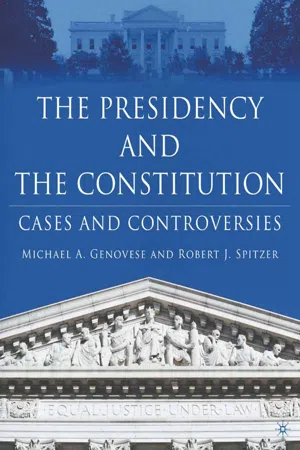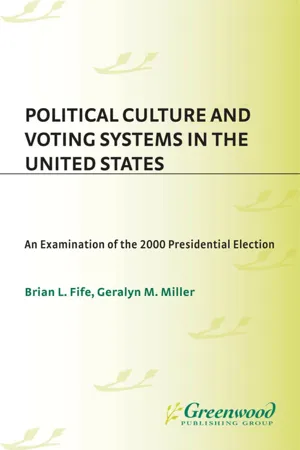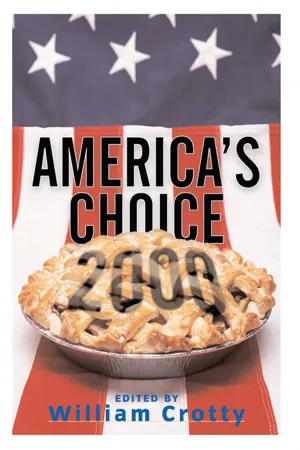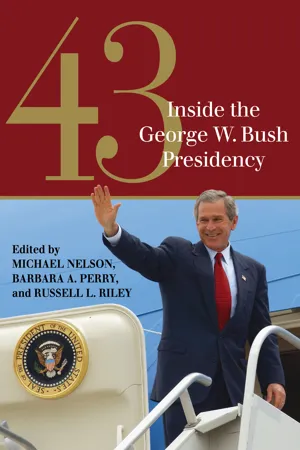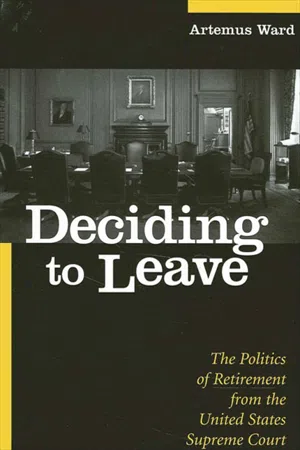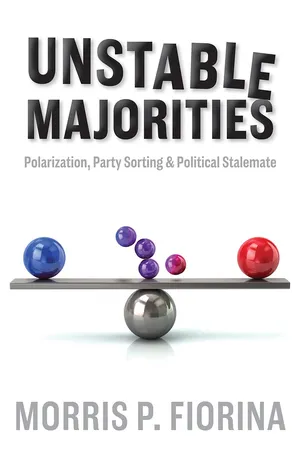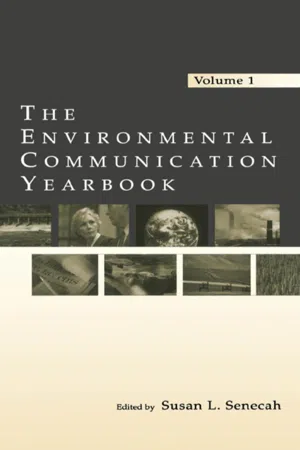History
2000 Presidential Election
The 2000 Election refers to the presidential election in the United States between Republican candidate George W. Bush and Democratic candidate Al Gore. The election was highly controversial due to issues with ballot counting in Florida, ultimately leading to a Supreme Court decision that resulted in Bush winning the presidency. This election highlighted the importance of accurate voting processes and had a significant impact on American politics.
Written by Perlego with AI-assistance
Related key terms
1 of 5
10 Key excerpts on "2000 Presidential Election"
- eBook - PDF
The Presidency and the Constitution
Cases and Controversies
- M. Genovese, R. Spitzer(Authors)
- 2005(Publication Date)
- Palgrave Macmillan(Publisher)
59 Buckley v. Valeo 60 Bush v. Gore 64 T he 2000 Presidential Election in the United States was a cynic’s paradise and a democrat’s nightmare. With a plot seemingly taken from a baroque Graham Greene novel of colonial corrup- tion and imperial arrogance, Election 2000 chal- lenged many of the sacred assumptions Americans once held about the integrity of the electoral process and the legitimacy of their govern- mental system. Called into question were the core democratic values Americans long took for granted. Election 2000 was anything but ordinary. Indeed, it was an international embarrassment for the United States. After decades of monitoring elections in other countries to ensure democratic standards, the United States found itself trying to explain to others why the leader of the free world could not even get a vote count right! Arguably the closest, certainly the longest, demonstrably the costliest presidential campaign in history, this contest will be remembered for the strange thirty-six-day election aftermath, in which five Supreme Court justices finally selected the can- didate, from their own party, who lost the popular vote and actually may have lost the Electoral College vote. It was not supposed to be this way— not in America. How is one to understand and put into proper perspective the peculiarities of Election 2000? The postelection swirl of events perplexed rather than enlightened. So many ups and downs, so many possible outcomes hanging on a single judge’s decision or the interpretation of what to do about dangling, dimpled, or pregnant chads. As political scientists James Ceaser and Andrew Busch note, “There were two major questions at that moment that no one could answer: who would win, and who would decide who would win.” 1 We now know that George W. Bush won; we also know that it was the U.S. Supreme Court that ultimately handed him the presidency. In the end, Bush became president in one of the closest elections in presidential history. - eBook - PDF
Political Culture and Voting Systems in the United States
An Examination of the 2000 Presidential Election
- Brian L. Fife, Geralyn M. Miller(Authors)
- 2002(Publication Date)
- Praeger(Publisher)
Chapter 1 The 2000 Presidential Election A CLOSE CONTEST The 2000 Presidential Election has been the focus of a great deal of scholarship. The sheer closeness of the contest is undoubtedly the primary motivational fac- tor that has led many evaluators to scrutinize what really happened, particu- larly in the state of Florida, and to ascertain why the choice of the people, Dem- ocrat Al Gore, did not occupy 1600 Pennsylvania Avenue as of January 20, 2001. The proximity of this race is depicted in Table 1.1. With more than 105 million votes cast, the "official" margin of difference be- tween Gore and Republican George W. Bush, who both garnered the support of more than 50 million individuals, was 540,520 votes. This was fewer than the more than 613,000 voters who voted for candidates other than Gore, Bush, Ralph Nader, or Pat Buchanan (see Table 1.1). The more important tally under Article II of the U.S. Constitution, however, is the vote in the Electoral College. The framers of the Constitution stipulated that to be elected president, a candidate must receive a simple majority in the Electoral College. Today, there are 538 total electoral votes. Thus, 270 votes are needed to win the election; otherwise, the electoral outcome is determined in the U.S. House of Representatives. Un- like some other elections, where the popular vote was close but the vote in the Electoral College exaggerated the margin of victory (e.g., John F. Kennedy ver- sus Richard Nixon in 1960), the Electoral College vote was indeed reflective of a very close election and a divided electorate, as is illustrated in Table 1.2. By "winning" Florida, Bush received 271 votes in the Electoral College (one more than is required by the Constitution). A number of different scenarios would have catapulted Gore into the White House (besides the Florida court bat- tles). A victory in his home state (Tennessee) would have made him president. - eBook - ePub
Modern America: A Documentary History of the Nation Since 1945
A Documentary History of the Nation Since 1945
- Robert H Donaldson(Author)
- 2014(Publication Date)
- Routledge(Publisher)
Fahrenheit 911 , showed a Bush administration detached from the human consequences of the September 11 attacks and the wars in Afghanistan and Iraq. Conservative talk show hosts railed against liberals, whom they accused of being unpatriotic in their lack of fervor for the war. Seeking the Democratic presidential nomination, former Vermont governor Howard Dean received enthusiastic support for his strong stance against the war in Iraq. The Democratic nominee, John Kerry, took a more balanced stance, but in the process failed to offer a clearly defined alternative to the Bush administration’s policies. In November 2004, George W. Bush won a second close election to begin his second term in office.In the early spring of 2005 Iraq held its first national election and a year later formed its first elected government, but the insurgency continued, as did the threat of civil war.DOCUMENT 20.1 The 2000 Presidential Election: A Contested OutcomeSOURCE: 531 U.S. (2000) No. 00-949.In the 2000 presidential race, Texas governor George W. Bush defeated Vice President Al Gore in a hotly contested election that was tainted—or at least questionable—in the minds of many participants. The first of two texts below is an excerpt from the U. S. Supreme Court decisionBush v. Gore(issued December 12, 2000). The court concluded, for a variety of reasons, that the decision by the Florida Supreme Court to continue the recounting of votes should be overturned and the recount should be ended. The second text is George W. Bush’s victory speech, delivered the next day at the Texas State House in Austin.Bush v. Gore (December 12, 2000)
The right to vote is protected in more than the initial allocation of the franchise. Equal protection applies as well to the manner of its exercise. Having once granted the right to vote on equal terms, the State may not, by later arbitrary and disparate treatment, value one person’s vote over that of another. It must be remembered that “the right of suffrage can be denied by a debasement or dilution of the weight of a citizen’s vote just as effectively as by wholly prohibiting the free exercise of the franchise.” Reynolds v. Sims - eBook - ePub
America's Choice 2000
Entering A New Millenium
- William Crotty(Author)
- 2018(Publication Date)
- Routledge(Publisher)
Five The Curious and Close Presidential Campaign of 2000 James E. CampbellTHE PRESIDENTIAL ELECTION OF 2000 BETWEEN REPUBLICAN Governor George W. Bush of Texas and Democratic Vice President Al Gore was the closest presidential election in American history, and there have been a number of very close presidential contests.1 In the twentieth century, there was the controversial Kennedy-Nixon election of 1960, the surprising come-from-behind victory of Truman over Dewey in 1948, as well as Wilson's razor-thin reelection over Hughes in 1916, the post-Watergate squeeker of 1976 and the turbulent Vietnam-era election of 1968. The later half of the nineteenth century also had several exceedingly close presidential contests, including the disputed I laycs-Tiiden race of 1876 and the Cleveland-Blaine "rum, romanism, and rebellion" race of 1884.Table 5.1 lists the closest presidential elections since 1828. They are ranked by the minimum vote change (as a percentage of the total national vote) that could have changed the election's electoral vote winner. In each of these elections, a change in one or more states of less than two-tenths of one percent of the national vote would have changed the election's result. The election of 2000 heads the list. A shift of fewer than a thousand votes in Florida, representing less than one-thousandth of one percent of votes cast nationwide, would have changed Florida's electoral votes and, thereby, the national electoral vote winner. Even beyond Florida, there were a half dozen other states decided by razor-thin margins.Table 5.1 The Most Narrowly Decide Presidential Elections, 1828-2000Four Phases in the Campaign
Voters traveled a winding road to get to this near dead-heat election result. In examining the polls conducted throughout the campaign, there were four rather distinct phases. These are summarized in Table 5.2 - eBook - PDF
The Final Arbiter
The Consequences of Bush v. Gore for Law and Politics
- Christopher P. Banks, David B. Cohen, John C. Green, Christopher P. Banks, David B. Cohen, John C. Green(Authors)
- 2012(Publication Date)
- SUNY Press(Publisher)
W. Bush’s 1988 victory to win a majority of the popular vote (50.9 percent). In addition, none of the big battleground states (e.g., Florida, Ohio, and Pennsylvania) had vote margins close enough to raise great and immediate doubt about the identity of the victor. As one post- election report put it, “the margin of victory exceeded the margin of litiga- tion” (Electionline.org 2004: 2). Still, Election 2004 suffered many of the legal and political problems of the 2000 campaign. Several states, including Ohio, conducted election recounts while others, such as Florida, were called into question. Allegations of fraud, incompetence, and conspiracy abounded on the Internet and in the alternative press. 2 Even though the margin of victory was large by 2000 stan- dards, the reluctance by many to embrace Bush’s re-election indicated that the lessons learned from Bush v. Gore were influencing election strategies from both campaigns, as well as in the courts. On November 23, 2004, the General Accountability Office (GAO), an independent research agency of Congress, launched an investigation into whether provisional ballots were handled improperly by many states, and whether there were significant vot- ing irregularities caused by voting machine malfunctions (Margasak 2004). The GAO’s decision coincided with ongoing litigation in the states chal- lenging election procedures, vote counts, and related campaign activities that were alleged to have made the election unfair. DAVID B. COHEN AND CHRISTOPHER P. BANKS 264 ARMIES OF L AW Y E R S Bush v. Gore impacted Election 2004 in several ways. As predicted by politi- cal scientist Andrew Busch (see chapter 10), the specter of litigation may have become an institutionalized part of the American electoral process. Even before a single vote had been cast and long before Election Day, armies of lawyers in the battleground states were assembled and poised to do battle in the courts and in the media. - eBook - ePub
43
Inside the George W. Bush Presidency
- Barbara A. Perry, Michael Nelson, Russell L. Riley(Authors)
- 2022(Publication Date)
- University Press of Kansas(Publisher)
C H A P T E R O N E
George W. Bush’s Elections: 2000, 2002, 2004, 2006, and 2008 Michael NelsonCommentators on twenty-first-century presidential elections often note that they include two of the five contests in American history in which the candidate who received the most popular votes was defeated in the Electoral College. George W. Bush’s victory over Al Gore in 2000 was one of those two elections. Observers also note that as of 2020, the Republican nominee won more popular votes than his Democratic opponent in only one election since then. Bush’s reelection in 2004 was that one election.Taking an even broader historical perspective, students of American political parties and elections have made much of the fact that no long-lasting partisan realignment—such as those that made the Republicans the nation’s majority party starting in the 1890s and the Democrats the majority party starting in the 1930s—has occurred in nearly a century. Of the six presidential elections in the period from 2000 to 2020, Democrats and Republicans each won three. Democrats controlled Congress for four years during this period, Republicans for eight and a half years, and control was divided between the parties—one with a majority in the House of Representatives and the other with a majority in the Senate—for the remaining seven and a half years.Arguably, Bush’s election and reelection constitute the century’s most serious effort to bring about a partisan realignment. Indeed, despite losing the 1992 and 1996 elections to Bill Clinton and seeing Clinton’s Democratic Party actually gain seats in the 1998 midterm election, the Republican Party was on a steep upward course during the first three contests of Bush’s presidential career: his election in 2000, his party’s gains in the 2002 midterm, and his reelection in 2004. - eBook - PDF
Deciding to Leave
The Politics of Retirement from the United States Supreme Court
- Artemus Ward(Author)
- 2012(Publication Date)
- SUNY Press(Publisher)
The disputed election of 2000 between Republican George W. Bush and Democrat Al Gore is the most recent event to have an impact on the depar- ture process. Both Chief Justice Rehnquist and Justice O’Connor voted with the majority in the case that effectively gave the election to Bush. Both have 212 DECIDING TO LEAVE FIGURE 9.1 Life Expectancy: U.S. White Males versus U.S. Supreme Court Justices, 1940–2000 90 70 50 30 10 1940 1960 1980 1990 2000 Year 62.1 74.0 67.4 74.9 70.7 79.2 72.7 79.3 74.2 87.2 United States – White males United States Supreme Court Note: Life expectancy for African-Americans and women is five years less, on aver- age, than white males. been retirement eligible for some time and with their overall conservative judicial philosophies, it is likely that each will depart during the Bush admin- istration. Conversely, both Justice Stevens and Justice Ginsburg voted against Bush in the election case. Though both have battled cancer, and despite Gins- burg nearing seventy and Stevens being in his eighties, their more liberal vot- ing record suggests they will remain on the Court until at least after the 2004 and possibly the 2008 presidential election. Indeed, this is precisely what occurred after the disputed 1876 election when Justices Davis, Clifford, Swayne, and possibly Strong based their departure decisions on whether they supported Republican Rutherford B. Hayes or Democrat Samuel Tilden. In the latter half of the chapter, I will analyze the current members of the Court in light of the circumstances surrounding this new emergent structure. THE DISPUTED ELECTION OF 2000: BUSH V. GORE Democrat Bill Clinton made two appointments to the Court in his first two years in office. During the last six years of his tenure, however, there were no vacancies at the inn. Speculation mounted that retirement-eligible members of the Court were waiting until after the 2000 election. - eBook - ePub
Unstable Majorities
Polarization, Party Sorting, and Political Stalemate
- Morris P. Fiorina(Author)
- 2017(Publication Date)
- Hoover Institution Press(Publisher)
CHAPTER 10 The 2016 Presidential Election—An Abundance of ControversiesEven by the colorful standards of presidential primaries, the 2016 election cycle has been filled with jaw-dropping, head-scratching moments .—Eric BradnerWhile the world celebrates and commiserates a Donald Trump presidency, one thing is clear: this will go down as the most acrimonious presidential campaign of all .—Rachel ReveszControversial presidential elections are nothing new in American electoral history, 2016 being the latest, but certainly not the first. Despite much apocalyptic commentary, however, the implications of the 2016 election seem less dire than those of some elections held in earlier eras. The four-candidate 1860 election started the country on the path to civil war and the disputed election of 1876 threatened to reignite that conflict. In more recent times, the strong showing of a racist third party in 1968 coupled with political assassinations and civil disorders on a scale not seen since the labor violence of the early twentieth century led some contemporary observers to believe that the country was “coming apart.”1 The 2000 Florida electoral vote contest raged for more than two months, threatening a constitutional crisis and deeply dividing partisan activists on both sides. Still, even allowing for the fact that secession and revolution are not seriously on the table, for the sheer number and breadth of the controversies that accompanied it, the 2016 election does seem out of the ordinary.Parties have nominated flawed candidates before—Republican Barry Goldwater in 1964 and Democrat George McGovern in 1972, for example—but at least since the advent of scientific survey research, no major party has nominated a candidate so wanting in the eyes of the electorate, let alone both doing so simultaneously. Charges of ethnocentrism and racism are as American as apple pie, but in their prevalence and virulence in 2016 (with misogyny added to the toxic mix) they were reminiscent of 1928, if not the late nineteenth century.2 “Biased media” is a complaint common to all elections, but the retreat from objectivity by the mainstream media in 2016 struck many observers as a significant break with modern journalistic practices.3 The increasingly visible role of social media like Twitter threatened to further diminish the importance of the legacy media. Swing voters, largely missing in action in recent elections, suddenly reappeared in 2016.4 Possible foreign intervention in the election was a new development (at least insofar as the United States was the intervenee rather than the intervener), as was FBI involvement (but possibly only because earlier instances did not become public). Meanwhile journalists scrambled to read up on “populism,” which had not played such a significant role in American elections since the 1960s. “Class,” long ago displaced by discussions of race, ethnicity, gender, and sexual orientation in college course syllabi, enjoyed an academic as well as political revival (so did “authoritarianism,” another oldie but goodie).5 - eBook - ePub
- Susan L. Senecah(Author)
- 2004(Publication Date)
- Routledge(Publisher)
CHAPTER ELEVENFraming of Newspaper News Stories During a Presidential Campaign Cycle: The Case of Bush-Gore in Election 2000
Michael Nitz University of North DakotaHolly West Mountain View HospitalThe presidential election of 2000 will go down in history as one of the closest ever. It was one of only three elections (along with 1876 and 1888) in which the popular vote winner did not receive an Electoral College majority. It ended with the closest possible division of seats in the Senate, fourth closest in the House, and second closest electoral vote (Ceaser & Busch, 2001). Wayne (2001), in his overview of the events of Election 2000, stated that the presidential campaign was the most expensive, one of the longest, and highly competitive. Ceaser and Busch (2001) called it the Perfect Tie, because almost all partisans voted for candidates from their own party and all the short-term factors worked equally on voters in different and offsetting directions.This chapter argues that the environment was possibly one of those factors. Early prognosticating seemed to indicate that the environment was shaping up as a critical issue in both the Democratic primary and the 2000 general election (Ceaser & Busch, 2001). The environment was an issue on which candidates differed substantially (Abramson, Aldrich, & Rohde, 2002). Gore had been anointed as the most pro-environment presidential candidate in modern history who would make environmental protection the centerpiece of his administration. Bush’s record on the environment had been criticized almost from the announcement of his candidacy. Ralph Nader, as candidate for the Green Party, tried to place environmentalism on the campaign agenda.How this issue of the environment was framed in media coverage during the 2000 presidential campaign cycle is the focus of this chapter. First, the nature of environment as a political issue is discussed. Second, the media are introduced as key shapers of this process. Third, framing is proffered as a concept that can help explain this process. Iyengar’s (1991) predominant frame thematic-episodic conceptualization, along with several other aspects associated with framing, is discussed. - No longer available |Learn more
- Stephen Wayne(Author)
- 2019(Publication Date)
- Cengage Learning EMEA(Publisher)
Despite misgivings about some aspects of the president’s personal character and behavior, voters saw him as more caring, more in touch with the times, and more visionary than his Republican opponent, Robert Dole, and they responded accordingly, reelecting the Democratic president but also the Republican congressional majority. 2000–2012: Partisanship, Ideology, and Incumbency Although the 2000 election could have been another referendum on the Clinton presidency (as many perceive the 1988 election was on the Reagan presidency), it was not. Vice President Al Gore sought to distance himself from the scandals of the Clinton years; he emphasized the policy differences between himself and Governor George W. Bush rather than contrasted the economic, social, and international conditions at the end of 2000 with those of 1992, the last time the Republicans controlled the White House. Encouraging voters to make more of a prospective choice than a retrospective judgment turned out to be a poor strategic decision for the vice president. Gore’s Copyright 2020 Cengage Learning. All Rights Reserved. May not be copied, scanned, or duplicated, in whole or in part. Due to electronic rights, some third party content may be suppressed from the eBook and/or eChapter(s). Editorial review has deemed that any suppressed content does not materially affect the overall learning experience. Cengage Learning reserves the right to remove additional content at any time if subsequent rights restrictions require it. 248 Chapter 9 proportion of the Democratic vote dropped below Clinton’s. By severing his ties with the Clinton administration, Gore hurt his own candidacy. 38 He won the popu-lar vote but not the Electoral College vote. Although third-party candidates Ralph Nader and Pat Buchanan attracted much less attention and support than Perot, the closeness of the 2000 election enhanced their influence, especially Nader’s.
Index pages curate the most relevant extracts from our library of academic textbooks. They’ve been created using an in-house natural language model (NLM), each adding context and meaning to key research topics.
